 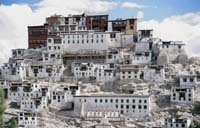 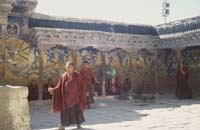 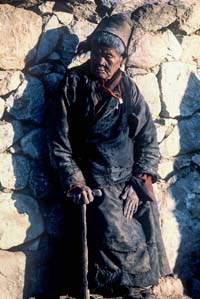 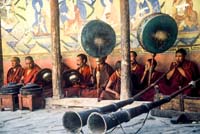 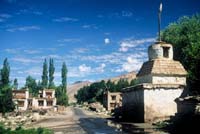  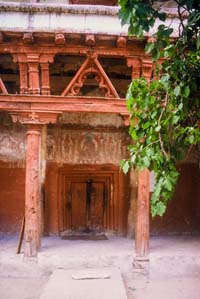  |
Seven Days in Ladakh Day 1 – Delhi to Leh Take the very early (last time I did this it, it was at 6AM!) flight to Leh. Arrive at the airport early enough to get window seats – it is absolutely spectacular. The prevailing wisdom is that travellers should rest, lying down, for several hours to help acclimatize to the 11,400 ft. altitude. You might use this opportunity to talk to the front desk about setting up some sightseeing. After you’ve got your breath back, you may want to explore the town that was once known as the “Central Asian Diamond”. The scruffy, run-down appearance of today belies that fact that this was once, as the junction between Lhasa, Kashgar, and Kashmir, a very wealthy trading post. It was these wealthy merchants who were the patrons of the beautiful monasteries in the area. Under normal circumstances you would probably want to walk, but on your first day here, think about taking a tum-tum. Ask to go to the market or to the German Bakery and you will end up in the interesting area. Breath permitting, walk up to the abandoned 16th C. Khar Palace, the former residence of the royal family who now live at Stok. Day 2 – Leh – In terms of acclimatization, this might be a good day to set off west to visit Lamayuru, visiting Alchi along the way. Alchi, one of India’s most ancient monasteries – and one of the few in Ladakh that does not have a steep climb to be reached. It’s located about 35 miles west of Leh and the drive out there, down the Indus River and past little villages nestled in the Zanskar mountain range is magnificent. At first glance, Alchi is a bit disappointing. It is a collection of low ramshackle stucco buildings, but the art that it contains is famous throughout the Buddhist world. The frescoes and statues in the two oldest buildings, the Dukhang and Sumtsek, date from the middle of the 11th C. These are some of the world’s very few remaining paintings done in the Kashmiri style. The Kashmiri painters launched the style of Buddhist art that was eventually carried up the Silkroad into China. After Buddhism was eradicated from India and the monasteries destroyed by the invading Moslem armies, this style of art was almost lost. Art historians note the style of the cloths and the shape of the heads and bodies to identify these subjects as Indian. Note also how the eyes are depicted in the partially profile faces – the back eye will protrude from the profile – a sure sign of a Kashmiri painter. Other buildings in the complex contain paintings done in a later and more Tibetan style. Not too far away is the Likkir Monastery. If you don’t think you’ll burn out on monasteries, it’s worth a visit. It belongs to the Gelugpa sect and (for a while at least and may still be – I don’t know) the younger brother of the Dalai Lama was the abbot. Spend the night in the village near Alchi. All the hotels are small guesthouse type affairs and I had good luck a while back with the Heritage Home, although it’s not particularly “heritage”. Day 3 – Lamayuru Continue the drive west to Lamayuru Monastery which will be a few hours. It sits at 11,500 feet and – I’m sorry to say – there will be some steps. Isolated and remote, Lamayuru gompa is the oldest and one of the largest monasteries in Ladakh and belongs to the Kaguyupa sect. Its founding reaches back to the age of myth when it was magically built after being prophesied by the Arhat Nimagun. Spend the day visiting this spectacular area. There are about 150 monks in residence here and they are very happy to show you around. The buildings are nestled into the mountains, surrounded by bizarre rock formations which the Ladakhis believe were formed when the waves of the nearby lake were petrified. If you wish, you can walk out to the enormous Buddha Maitreya carved into the side of a cliff. Spend the night in one of the nearby guesthouses here and enjoy the sunset over the spectacular mountain scenery. Day 4 – Return to Leh Take your time in the morning light to enjoy the setting around Lanayuru. The drive back to Leh will be about 4 hours. Day 5 – Hemis and Tikse Perhaps you would like to visit some of the monasteries which lie to the east of Leh today. There are several, but Hemis and Tikse are probably the most famous. On the way there, you will probably stop at Shey, the abandoned old capital of Ladakh. There is still some very beautiful artwork in the old palace and monastery, but the claim to fame there is the wonderfully photogenic field of chortens. Also be sure to find the Dhyani Buddhas (The Buddhas of the Five Ages) which are painted on stone near the street. Tikse Monastery clings to the side of a hill – it’s a bit of a climb up to the top, but well worth it. This is a 15th C. Gelugpa monastery and is one of the most active in the valley with hundreds of monks in residence. The most important piece of artwork is the 2 story high Buddha Maitreya, the Buddha of the Future. Hemis Monastery belongs to the Nyngmapa sect and is the wealthiest in Ladakh. Hidden inside the folds of the mountains, it escaped the iconoclastic Moslem invaders of the 14th C. and contains a huge collection of Buddhist artifacts. Some Buddhist scholars believe that Jesus, known here as Issa, spent time here during his teenage years. Day 6 – Free day in Leh There’s a lot to see in this vibrant town. The architecture is Tibetan in style and the little alleyways are full of traditional Ladakhi people. There’s a lot of shops and little cafes to hang out in. Day 7 – fly back to Delhi |
